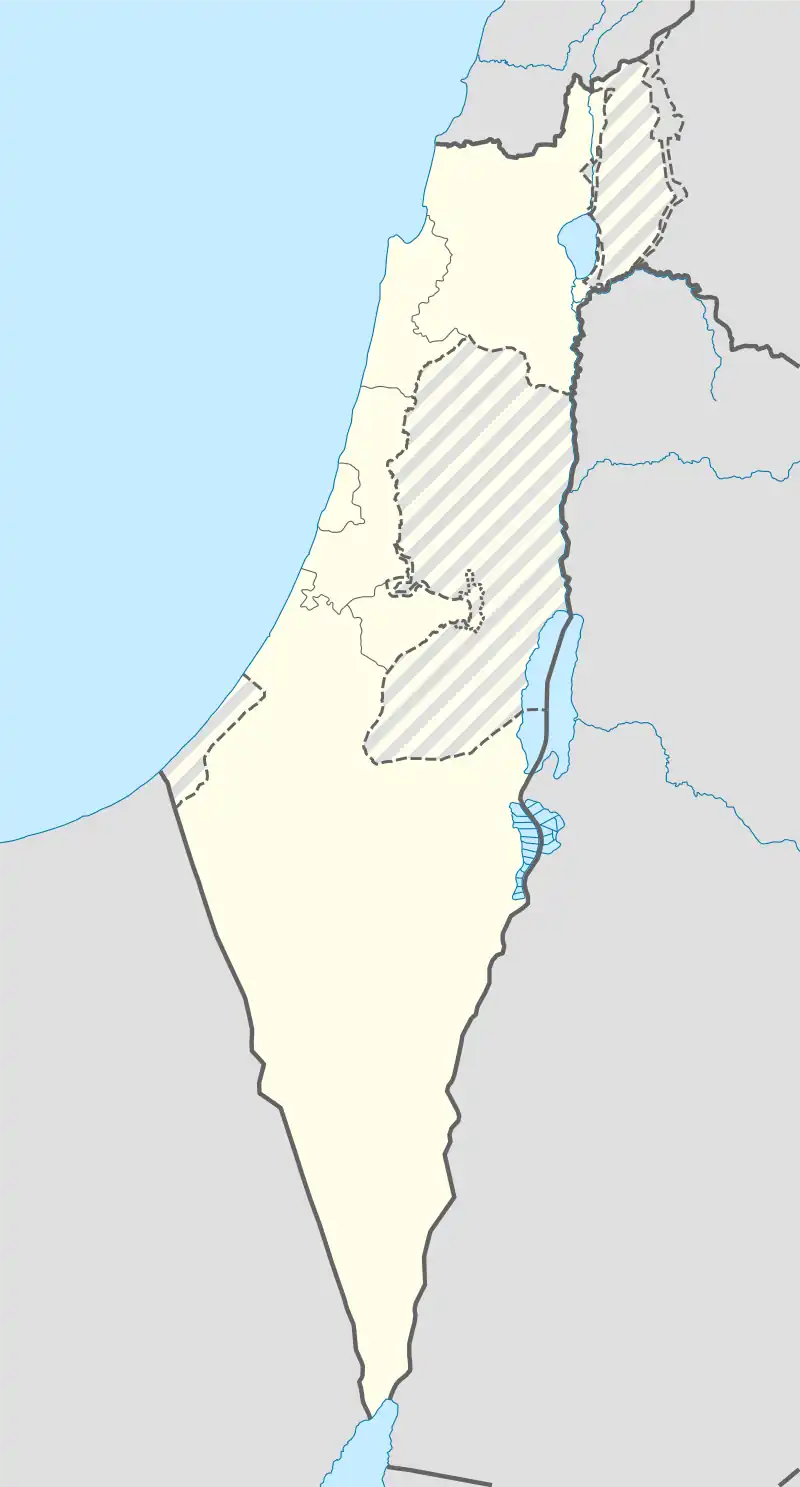Bareket
בַּרֶקֶת باركيت | |
|---|---|
 Bareket  Bareket | |
| Coordinates: 32°0′54″N 34°56′39″E / 32.01500°N 34.94417°E | |
| Grid position | 144/158 PAL |
| Country | |
| District | Central |
| Council | Hevel Modi'in |
| Affiliation | Hapoel HaMizrachi |
| Founded | 1952 |
| Founded by | Yemenite Hapoel HaMizrachi members |
| Population (2021)[1] | 2,192 |
Bareket (Hebrew: בַּרֶקֶת, lit. 'Emerald') is a moshav in central Israel. Located in the Shephelah around five kilometres north-east of Ben Gurion International Airport and covering 2,500 dunams, it falls under the jurisdiction of Hevel Modi'in Regional Council. In 2021 it had a population of 2,192.[1]
History
Prior to 1948, Bareket was the site of the Palestinian Arab village of al-Tira (Tirat Dandan). It belonged to the Nahiyeh (sub-district) of Lod that encompassed the area of the present-day city of Modi'in-Maccabim-Re'ut in the south to the present-day city of El'ad in the north, and from the foothills in the east, through the Lod Valley to the outskirts of Jaffa in the west. In the 1945 statistics its population was 1,290, all Arab Muslim.[2] However, the village was depopulated on 10 July 1948 after a military assault by the Israeli army.[3] On the same day, Operation Danny headquarters ordered the Yiftach Brigade to blow up most of Innaba and al-Tira, leaving only houses enough for a small garrison.[4][5]
The village of Bareket was established in 1952 by members of Hapoel HaMizrachi who had immigrated from Habban District in south-east Yemen. The new village was built on the ruins al-Tira.[6] It was initially named Kfar Halutzim (Pioneers' Village) and then Tirat Yehuda Bet (after nearby Tirat Yehuda), before adopting its current name. Like other villages nearby as Nofekh, Shoham, Leshem and Ahlama (the former name of Beit Arif) nearby, the name relates to one of the 12 stones in the Hoshen, the sacred breastplate worn by a Jewish high priest (Exodus 28:17).[7][8][9][10]
Transportation
Roads
The village has one entrance off of Highway 4613, an East-West road of local importance. This entrance has a gate, a security guard kiosk and a large stone entrance sign. Highway 4613 connects to Highway 444 on the East, which connects to El'ad in the North, Shoham and Highway 1 to Jerusalem in the South. On the West, highway 4613 connects to Highway 40 and Highway 46, which provide connection to Petah Tikva, Tel Aviv-Jaffa, and Ben Gurion Airport.
Despite being only two kilometres away from Highway 6 (Trans-Israel Highway), the village has no direct access.
Public Transportation
The village of Bareket is served by four bus routes, run by Kavim Company. four bus routes, 173 and 385 circulate within the village itself, whereas bus routes 58 and 85 have a stop just at the main entrance of the village off of Highway 4813.
- Line 58 (Kavim) connects Shoham to Ramat Gan, running once every 1 hour and 25 minutes throughout the day.[11] The line does not run on Shabbat. This bus has a stop at the entrance of Bareket.
- Line 85 (Kavim) connects Shoham to Petah Tikva, running once every 25 minutes throughout the day.[12] The line does not run on Shabbat. This bus has a stop at the entrance of Bareket.
- Line 173 (Kavim) connects El'ad to Ramat Gan, running every 1 hour and 25 minutes throughout the day.[13] The line alsp runs on Shabbat. This bus circulates the streets of the village.
- Line 385 (Kavim) connects Shoham Industrial Park to Petah Tikva, running every 2 hour and 10 minutes throughout the day.[14] The line does not run on Shabbat. This bus circulates the streets of the village.
References
- 1 2 "Regional Statistics". Israel Central Bureau of Statistics. Retrieved 22 February 2023.
- ↑ Department of Statistics (1945). Village Statistics, April, 1945. Government of Palestine. p. 30
- ↑ Morris, B. (2004). The Birth of the Palestinian Refugee Problem Revisited. Cambridge University Press. ISBN 978-0-521-00967-6., p. xviii village #216. Also gives cause of depopulation.
- ↑ Morris, 2004, p. 355, note #86
- ↑ Morris, 2004, p. 400, note #86
- ↑ Khalidi, Walid (1992). All That Remains: The Palestinian Villages Occupied and Depopulated by Israel in 1948. Washington D.C.: Institute for Palestine Studies. p. 418. ISBN 0-88728-224-5.
- ↑ Carta's Official Guide to Israel and Complete Gazetteer to all Sites in the Holy Land, p94 ISBN 965-220-186-3
- ↑ Place Names in Israel. A Compendium of Place Names in Israel compiled from various sources, p258
- ↑ Arie Yizhaqi (1980) Madrich Israel Vol.9, Keter Press, p377 (in Hebrew)
- ↑ Hanna Bitan (1999) 1948-1998: Fifty Years of 'Hityashvut': Atlas of Names of Settlements in Israel, Carta, p14 ISBN 965-220-423-4 (in Hebrew)
- ↑ Moveit App, Bus 58 - Shoham - Ramat Gan (Hebrew) https://moovitapp.com/index/he/תחבורה_הציבורית-line-58-Israel-1-13-7009-1
- ↑ Moveit App, Bus 85 - Shoham - Petah Tikva (Hebrew) https://moovitapp.com/index/he/תחבורה_הציבורית-line-85-Israel-1-13-205278-1
- ↑ Moveit App, Bus 173 - El'ad - Ramat Gan (Hebrew) https://moovitapp.com/index/he/תחבורה_הציבורית-line-173-Israel-1-13-428421-0
- ↑ Moveit App, Bus 173 - El'ad - Ramat Gan (Hebrew) https://moovitapp.com/index/he/תחבורה_הציבורית-line-385-Israel-1-13-54334093-0